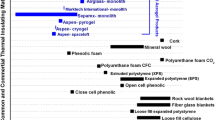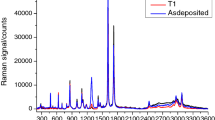Abstract
Silica aerogel composites reinforced with different aramid fibres have been synthesized and compared considering their potential use in thermal protection systems of Space devices. These composites were prepared from tetraethoxysilane and vinyltrimethoxysilane and the network was strengthened with aramid fibres. The results showed that the physical and chemical properties of the fibres were relevant, leading to composites with different properties/performance. In general, the obtained values for bulk density were low, down to 150 kg m−3. Very good thermal properties were achieved, reaching thermal conductivities bellow 30 mW m−1 K−1, and thermal stability up to 550 °C in all cases. Short length fibres produce stiffer composites with lower thermal conductivities, while among longer fibres, meta-aramid-containing fibres lead to nanocomposites with best insulation performance. Standard tests for Space materials qualification, as thermal cycling and outgassing, were conducted to assess the compliance with Space conditions, confirming the suitability of these aerogel composites for this application.
Graphical abstract







Similar content being viewed by others
Data Availability
The raw/processed data required to reproduce these findings cannot be shared at this time as the data also forms part of an ongoing study.
References
Aegerter MA, Leventis N, Koebel MM (2011) Aerogels handbook. Springer Science & Business Media, Berlin
Gurav JL, Jung I-K, Park H-H, Kang ES, Nadargi DY (2010) Silica aerogel: synthesis and applications. J Nanomater 2010:409310
Fesmire JE (2006) Aerogel insulation systems for space launch applications. Cryogenics 46(2–3):111–117
Sabri F, Marchetta J, Smith K (2013) Thermal conductivity studies of a polyurea cross-linked silica aerogel-RTV 655 compound for cryogenic propellant tank applications in space. Acta Astronaut 91:173–179
Durães L, Maleki H, Vareda JP, Lamy-Mendes A, Portugal A (2017) Exploring the versatile surface chemistry of silica aerogels for multipurpose application. MRS Adv 2(57):3511–3519
Thapliyal PC, Singh K (2014) Aerogels as promising thermal insulating materials: An overview. J Mater 2014:127049
Randall JP, Meador MAB, Jana SC (2011) Tailoring mechanical properties of aerogels for aerospace applications. ACS Appl Mater Interfaces 3(3):613–626
Maleki H, Durães L, Portugal A (2014) An overview on silica aerogels synthesis and different mechanical reinforcing strategies. J Non-Cryst Solids 385:55–74
Seydibeyoglu MO, Mohanty AK, Misra M (2017) Fiber technology for fiber-reinforced composites. Woodhead Publishing
Li Z, Cheng X, He S, Shi X, Gong L, Zhang H (2016) Aramid fibers reinforced silica aerogel composites with low thermal conductivity and improved mechanical performance. Compos A Appl Sci Manuf 84:316–325
Li Z, Gong L, Cheng X, He S, Li C, Zhang H (2016) Flexible silica aerogel composites strengthened with aramid fibers and their thermal behavior. Mater Des 99:349–355
Li Z, Gong L, Li C, Pan Y, Huang Y, Cheng X (2016) Silica aerogel/aramid pulp composites with improved mechanical and thermal properties. J Non Cryst Solids 454:1–7
Linhares T, de Amorim MTP, Durães L (2019) Silica aerogel composites with embedded fibres: a review on their preparation, properties and applications. J Mater Chem A 7(40):22768–22802
Ghica ME, Almeida CM, Fonseca M, Portugal A, Durães L (2020) Optimization of polyamide pulp-reinforced silica aerogel composites for thermal protection systems. Polymers 12(6):1278
Maleki H, Durães L, Portugal A (2014) Synthesis of lightweight polymer-reinforced silica aerogels with improved mechanical and thermal insulation properties for space applications. Microporous Mesoporous Mater 197:116–129
Berthon-Fabry S, Hildenbrand C, Ilbizian P (2016) Lightweight superinsulating resorcinol-formaldehyde-APTES benzoxazine aerogel blankets for space applications. Eur Polymer J 78:25–37
Marchetta J, Sabri F, Williams D, Pumroy D (2018) Small-scale room-temperature-vulcanizing-655/aerogel cryogenic liquid storage tank for space applications. J Spacecr Rocket 55(4):1007–1013
Hasan MA, Rashmi S, Esther ACM, Bhavanisankar PY, Sherikar BN, Sridhara N, Dey A (2018) Evaluations of silica aerogel-based flexible blanket as passive thermal control element for spacecraft applications. J Mater Eng Perform 27(3):1265–1273
Raja SN, Basu S, Limaye AM, Anderson TJ, Hyland CM, Lin L, Alivisatos AP, Ritchie RO (2015) Strain-dependent dynamic mechanical properties of Kevlar to failure: structural correlations and comparisons to other polymers. Mater Today Commun 2:e33–e37
Ertekin M (2017) Aramid fibers. Fiber Technology for Fiber-Reinforced Composites. Elsevier, Amsterdam, pp 153–167
Maleki H, Durães L, An P (2015) Development of mechanically strong ambient pressure dried silica aerogels with optimized properties. J Phys Chem C 119(14):7689–7703
Ismail Saltuk NA, Stevens C, Cengiz C (2019) ASTM D945–16 and the AYO-IV Yerzley mechanical oscillograph can improve rubber compounding and molding operations. Rubber World 259(4):44–47
ASTM D945–16, Standard Test Methods for Rubber Properties in Compression or Shear (Mechanical Oscillograph). (2016). https://doi.org/10.1520/D0945-16
ECSS-Q-ST-70–04C, Thermal testing for the evaluation of space materials, processes, mechanical parts and assemblies (2008). European Cooperation for Space Standardization (ECSS), Noorwijk, The Netherlands.
ECSS-Q-ST-70–02C, Thermal vacuum outgassing test for the screening of space materials (2008). European Cooperation for Space Standardization (ECSS), Noorwijk, The Netherlands.
Venkataraman M, Xiong X, Novotna J, Kašparová M, Mishra R, Militký J (2019) Thermal protective properties of aerogel-coated kevlar woven fabrics. J Fiber Bioeng Inform 12(2):93–101
Mukherjee M, Kumar S, Bose S, Das C, Kharitonov A (2008) Study on the mechanical, rheological, and morphological properties of short Kevlar fiber/s-PS composites. Polym Plast Technol Eng 47(6):623–629
Villar-Rodil S, Paredes J, Martínez-Alonso A, Tascón J (2001) Atomic force microscopy and infrared spectroscopy studies of the thermal degradation of Nomex aramid fibers. Chem Mater 13(11):4297–4304
Al-Oweini R, El-Rassy H (2009) Synthesis and characterization by FTIR spectroscopy of silica aerogels prepared using several Si (OR) 4 and R′′ Si (OR′) 3 precursors. J Mol Struct 919(1–3):140–145
Torres RB, Vareda JP, Lamy-Mendes A, Durães L (2019) Effect of different silylation agents on the properties of ambient pressure dried and supercritically dried vinyl-modified silica aerogels. J Supercrit Fluids 147:81–89
Petrov O, Furó I (2011) A study of freezing–melting hysteresis of water in different porous materials Part I: Porous silica glasses. Microporous Mesoporous Mater 138(1–3):221–227
Sing KS, Williams RT (2004) Physisorption hysteresis loops and the characterization of nanoporous materials. Adsorpt Sci Technol 22(10):773–782
Maleki H, Montes S, Hayati-Roodbari N, Putz F, Huesing N (2018) Compressible, thermally insulating, and fire retardant aerogels through self-assembling silk fibroin biopolymers inside a silica structure—an approach towards 3D printing of aerogels. ACS Appl Mater Interfaces 10(26):22718–22730
Yuan B, Zhang J, Mi Q, Yu J, Song R, Zhang J (2017) Transparent cellulose–silica composite aerogels with excellent flame retardancy via an in situ sol–gel process. ACS Sustain Chem Eng 5(11):11117–11123
He S, Sun G, Cheng X, Dai H, Chen X (2017) Nanoporous SiO2 grafted aramid fibers with low thermal conductivity. Compos Sci Technol 146:91–98
Xu G, Li M, Wu T, Teng C (2020) Highly compressible and anisotropic polyimide aerogels containing aramid nanofibers. React Funct Polym 154:104672
Lakatos Á, Trnik A Thermal characterization of fibrous aerogel blanket. In: MATEC Web of Conferences, 2019. EDP Sciences, p 01001.
Woignier T, Primera J, Alaoui A, Despetis F, Calas-Etienne S, Faivre A, Duffours L, Levelut C, Etienne P (2020) Techniques for characterizing the mechanical properties of aerogels. J Sol-Gel Sci Technol 93(1):6–27
Liu W, Huan Y, Dong J, Dai Y, Lan D (2015) A correction method of elastic modulus in compression tests for linear hardening materials. MRS Commun 5(4):641
ECSS-Q-70–71A Rev.1—Space product assurance—Data for selection of space materials and processes (2004). European Cooperation for Space Standardization.
Rocha H, Lafont U, Semprimoschnig C (2019) Environmental testing and characterization of fibre reinforced silica aerogel materials for Mars exploration. Acta Astronaut 165:9–16
Acknowledgements
This work was developed by University of Coimbra under the project AeroXTreme (CENTRO-01-0145-FEDER-029533)—“High-performance silica aerogel nanocomposites for insulation under extreme temperature Space environments”, co-funded by Foundation for Science and Technology (FCT) and by the European Regional Development Fund (ERDF), through Centro 2020—Regional Operational Program of the Centre of Portugal. We kindly thank Professor Benilde Costa for providing the SEM facilities used in the analysis of the fibres. Access to TAIL-UC facility, funded under QREN-Mais Centro Project ICT-2009-02-012-1890, is gratefully acknowledged. We also would like to thank to Teijin Aramid GmbH (Wuppertal, Germany) for kindly offer the fibres Twa, Tch and Teij.
Author information
Authors and Affiliations
Corresponding author
Additional information
Handling Editor: David Cann.
Publisher's Note
Springer Nature remains neutral with regard to jurisdictional claims in published maps and institutional affiliations.
Supplementary Information
Below is the link to the electronic supplementary material.
Rights and permissions
About this article
Cite this article
Almeida, C.M.R., Ghica, M.E., Ramalho, A.L. et al. Silica-based aerogel composites reinforced with different aramid fibres for thermal insulation in Space environments. J Mater Sci 56, 13604–13619 (2021). https://doi.org/10.1007/s10853-021-06142-3
Received:
Accepted:
Published:
Issue Date:
DOI: https://doi.org/10.1007/s10853-021-06142-3




